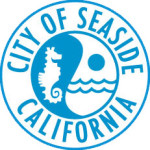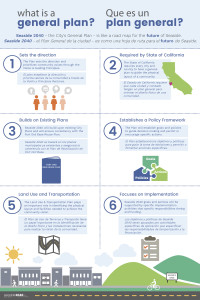The Plan
View the Proposed Final Draft General Plan!
Review all the past work resulting in the Proposed Final Draft General Plan (Seaside 2040)! Click here to review the document.
About Seaside 2040
The City of Seaside is undertaking a multi-year effort to develop a new General Plan, conduct the environmental review in accordance with the California Environmental Quality Act (CEQA), and ultimately adopt new development regulations, including zoning and subdivision provisions.
Process
The project consists of the following components:
- General Plan. All chapters in the existing General Plan will be comprehensively updated.
- Zoning Code. The process will develop several ordinances to update the zoning code in accordance with the General Plan.
- Environmental Impact Report. The team will prepare an Environmental Impact Report that analyzes and discloses the potential impact of the General Plan update and zoning code on the environment. This process is required by the State’s California Environmental Quality Act, or CEQA.
- Housing Element. Expanding from the Existing Conditions Report, Veronica Tam and Associates prepared the 5th cycle (2015 -2023) comprehensive update to the City’s Housing Element Technical Appendix which was adopted in 2020. They will now work on completing the 6th Cycle Housing Element (2023 – 2031).
- Community Engagement. A multi-faceted public outreach program is critical to the success of the project. There will be advisory committees, public workshops, neighborhood meetings, focus groups, surveys, a project website, and other outreach.
Timeline
The project began in early 2016 and continued until early 2018. Resuming in Spring 2022 the process is expected to be complete by 2023. The following describes the primary phases of work.
Completed Phases
- Phase 1: Existing Conditions Reports. The first part of the project is to document the existing conditions in the City. This task will include data collection on the City, reviewing existing City documents and policies, and meeting with the community. The result will be a detailed Existing Conditions Report.
- Phase 2: Visioning. Working closely with the community, the consultant team will develop a long-term vision for the City.
- Phase 3: Alternatives and Policy Development. During the existing conditions phase, a series of issues and opportunities about the City will be uncovered. During phase 3, the team will identify policy and design alternatives to address the key issues facing the City. Examples of issues that may be addressed include traffic congestion, the lack of park space, and crime. This phase will also include identifying areas of the community where land use and physical change are possible and then develop alternative scenarios for how these areas could transform over time.
- Phase 4: Plan Preparation. During this phase, the General Plan and zoning code will be written and reviewed by staff and then presented to the community.
Phases Happening Now
The General Planning process paused after the Public Draft was released due to limited resources, capacity, and staffing as well as a desire to focus on water allocation policy and the Campus Town Specific Plan. Impacts from the Covid–19 Pandemic further altered workflows, which will now resume.
- Phase 5: Plan Updates. Following the break, staff will continue plan preparation, making necessary additions to the previously released Public Draft General Plan to address new legislation requirements regarding housing, safety, environmental justice, and other updates, including the COVID-19 pandemic. As was the case before, community engagement will remain a crucial part of the process.
- Phase 6: Environmental Review. Concurrent with the preparation of the General Plan, the team will prepare an EIR that analyzed the potential impacts of future growth in Seaside. The EIR will be released for public review at approximately the same time as the General Plan and zoning code
- Phase 7: Review and Adoption. The General Plan, zoning code and EIR will be reviewed by the Planning Commission and City Council. The final document will be adopted by the City Council.
Throughout the entire project will be an aggressive public outreach and participation program. More information may be found on the Community Engagement page.
What is a General Plan?
A General Plan is a policy document required by state law that provides long-range guidance for land use, development and other City issues such as open space conservation, affordable housing and employment. Called Seaside 2040 your city, your future, the Seaside General Plan Update will serve as a blueprint the City's vision for the future. The policy document will replace the 2003 General Plan.
What is included in the General Plan?
State law establishes the basic components of a General Plan and how these components are to be interwoven to create a "long term", "comprehensive", "integrated, internally consistent and compatible statement" of goals and policies that reflect local conditions and circumstances. The law requires that a General Plan address seven subject areas, known in the law and by practice, as "elements", and that each element establish goals, policies and implementation programs and time frames for the subject matter in each element. The mandatory elements are:
- Land use. The land use element is a guide to the public, planners, and decision makers as to the pattern of development for the City at build out.
- Circulation. This element plans for the orderly circulation of people, goods, energy, water, sewage, storm drainage, and communications such as WIFI.
- Housing. The housing element seeks to accommodate the exiting and anticipated housing needs for all incomes and groups with disabilities, and the homeless.
- Open space. The open space element provides a comprehensive and long-range preservation of ‘open space land’, i.e., unimproved land or water devoted to open space.
- Conservation. The conservation element guides conservation, development of natural resources, i.e. Forests, Wetlands, Fisheries, Soils, Rivers, Harbors, Wildlife, Minerals, etc.
- Noise. This element seeks to limit the community’s exposure to excessive noise.
- Safety. The safety element seeks to reduce the risk of death, injuries, property damage, and economic and social dislocation from natural and manmade hazards.
- Environmental Justice. This element seeks to reduce the unique or compounded health risks of disadvantaged communities overburdened by pollution. A jurisdiction is required to adopt an EJ element, or set of EJ policies, goals, and objectives, if it identifies one or more disadvantaged communities within their jurisdiction.
- Note: Based on State guidance, the City did not identify any disadvantaged communities within its jurisdiction. For the purposes of an EJ element, a disadvantaged community is defined as a low-income community with one or more pollution burden at or above the 75th percentile of one or more CalEnviroScreen index scores. However, the City did identify a census block that is right below the 75th percentile threshold for diesel particulate matter and for traffic pollution. The census block is in the 74th percentile for both of these CalEnviroScreen index scores.
- Although an EJ element is not required based on this screening, the City will nonetheless formulate specific EJ policies and actions to address EJ issues related to diesel particulate matter and traffic pollution in this community.
Beyond the mandatory elements of the General Plan, there is a great deal of flexibility to address local conditions and circumstances through additional elements. Many General Plans contain elements that address the local economy, urban design, bicycle, and pedestrian needs, parks and recreation, social services, public health, sustainability, and so forth. There is also a great deal of flexibility in creating the format of the General Plan so that certain topics can be better integrated.







